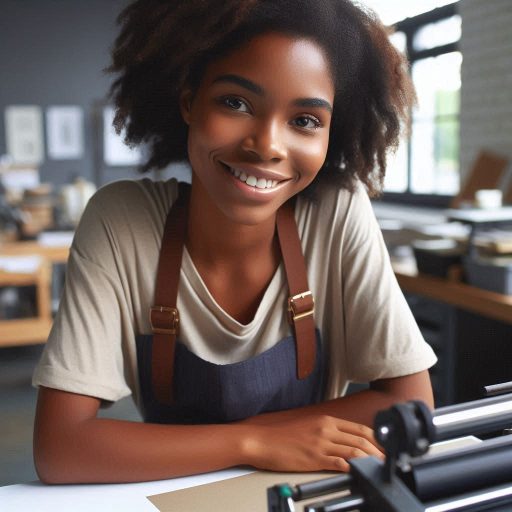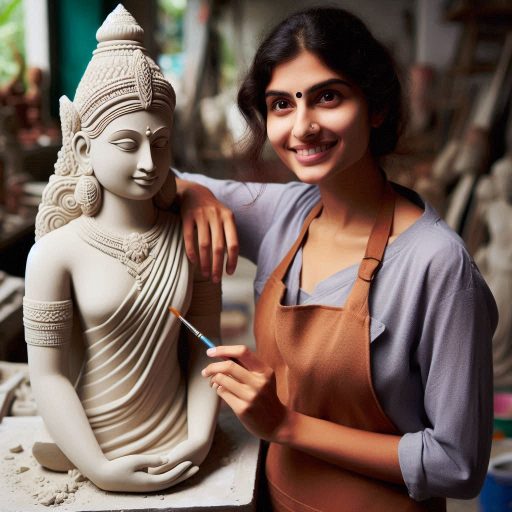Introduction
Public art sculptures are three-dimensional works displayed in open spaces accessible to everyone.
They range from abstract forms to realistic figures and can be found in parks, plazas, and streets.
These sculptures are designed to engage and inspire viewers while enhancing public spaces.
Public art holds significant importance in communities.
It transforms mundane environments into vibrant, thought-provoking spaces.
Sculptures contribute to local identity, reflect cultural values, and offer a sense of pride.
They create landmarks that people identify with and build connections to their surroundings.
Public art also fosters social interaction by providing a common point of interest and conversation.
The impact of public art sculptures on communities is profound.
They not only beautify and animate public spaces but also provoke thought and inspire creativity.
By incorporating diverse artistic expressions, public sculptures can address social issues, celebrate historical events, or simply provide aesthetic enjoyment.
Their presence can attract tourism, boost local economy, and enhance community cohesion.
In summary, public art sculptures play a crucial role in enriching public spaces and influencing community dynamics.
Their ability to engage, inspire, and provoke thought makes them an essential aspect of urban and rural landscapes.
History of Public Art Sculptures
Public art sculptures have a long and rich history dating back to ancient civilizations.
Throughout history, public art sculptures have been used to commemorate historical events, honor important individuals, and beautify public spaces.
Overview of Famous Public Art Sculptures Throughout History
Famous public art sculptures such as the Statue of Liberty, Michelangelo’s David, and the Great Sphinx of Giza have captured the imagination of people around the world.
These iconic sculptures have become symbols of culture, history, and artistry, attracting visitors and fostering a sense of pride in their communities.
How Public Art has Evolved Over Time
Public art has evolved from simple statues and monuments to include a wide range of mediums, styles, and themes.
Modern public art can be interactive, ephemeral, and site-specific, reflecting contemporary issues, values, and aesthetics.
Transform Your Career Today
Unlock a personalized career strategy that drives real results. Get tailored advice and a roadmap designed just for you.
Start NowExamples of Public Art Sculptures in Different Cultures
Public art sculptures can be found in diverse cultures around the world, each reflecting unique traditions, beliefs, and artistic expressions.
- The Terracotta Army in China is a stunning example of ancient public art that showcases the skill and craftsmanship of its creators.
- The Dancing House in Prague is a modern public art sculpture that challenges traditional notions of architecture and design.
- The Angel of the North in England is a monumental public art installation that has become a beloved symbol of the region.
These examples illustrate the power of public art sculptures to inspire, provoke thought, and foster a sense of identity and belonging within communities.
In fact, public art sculptures play a vital role in shaping the cultural landscape of communities, providing a platform for creativity, expression, and dialogue.
By exploring the history, evolution, and diversity of public art sculptures, we can better appreciate their impact on society and the lasting legacy they leave for future generations.
Read: Exploring Printmaking in Public Art Projects
Social Impact of Public Art Sculptures
Public art sculptures have a profound social impact on communities, fostering a sense of connectivity and pride.
Public art has the power to bring people together, regardless of their backgrounds or beliefs.
It serves as a common ground where individuals can come together to appreciate and discuss the artistic expressions it embodies.
How Public Art Can Promote Social Cohesion and Unity
By creating a shared experience, public art sculptures help bridge societal divides and foster a sense of belonging among community members.
When people gather to admire a sculpture or participate in a public art event, they are more likely to engage in meaningful conversations and build relationships with one another.
Public Art as a Form of Cultural Expression
Public art sculptures often reflect the cultural values and traditions of a community, serving as a visual representation of its identity.
This form of artistic expression not only beautifies public spaces but also preserves and promotes cultural heritage for future generations to appreciate.
Influence of Public Art on Community Identity and Pride
Public art plays a significant role in shaping the identity and pride of a community.
When a city invests in public art, it sends a message that it values creativity, culture, and the well-being of its residents.
This, in turn, boosts community pride and instills a sense of ownership among residents.
In short, public art sculptures have a transformative impact on communities, fostering social cohesion, promoting cultural expression, and enhancing community identity and pride.‘
Read: How to Market Yourself as a Professional Sculptor
Economic Impact of Public Art Sculptures
Public art sculptures have a significant economic impact on communities, with various benefits that contribute to the overall well-being and prosperity of the local area.
How Public Art Can Attract Tourists and Boost Local Economies
Public art has the power to attract tourists and visitors to a community, as people are drawn to unique and visually appealing art installations.
Showcase Your Business Today
Reach thousands of readers actively exploring professional services. Publish your business profile and grow your audience now.
Publish NowTourists often seek out cities and towns known for their art scene, which can result in increased foot traffic, spending at local businesses, and a boost in the local economy.
Public art sculptures create a sense of place and identity, making a community more memorable and enticing for tourists to explore.
This increased interest can lead to higher revenue for local businesses, such as restaurants, shops, and hotels, further stimulating the local economy.
Job Creation Through Public Art Projects
Public art projects not only contribute to the cultural enrichment of a community but also create employment opportunities for artists, designers, craftsmen, and other professionals involved in the creation and installation of art sculptures.
Additionally, public art initiatives often require collaboration with local businesses, government agencies, and community organizations, which can lead to partnership opportunities and job creation in various sectors.
These collaborations can also foster a sense of community pride and engagement.
Impact of Public Art on Property Values in Communities
Public art sculptures can have a positive impact on property values in communities, as they enhance the aesthetic appeal and overall desirability of a neighborhood.
Well-maintained and thoughtfully placed art installations can attract potential homebuyers and renters, leading to increased property values.
Studies have shown that neighborhoods with public art tend to experience higher property appreciation rates and a more vibrant real estate market.
Homeowners in these areas may also enjoy a sense of cultural enrichment and pride in their community, further contributing to the overall quality of life.
In essence, public art sculptures play a crucial role in boosting local economies, creating job opportunities, and enhancing property values in communities.
Read: The Business Side of Printmaking Art

Educational impact of public art sculptures
Public art sculptures have a significant educational impact on communities, particularly when it comes to inspiring creativity and critical thinking in students.
These sculptures offer a unique and tangible way for students to engage with art, sparking curiosity and imagination.
How public art can inspire creativity and critical thinking in students‘
Public art sculptures serve as a visual representation of creativity and artistic expression, encouraging students to think outside the box and explore new ideas.
By witnessing these sculptures in their communities, students are exposed to different forms of art and are encouraged to develop their own creative abilities.
Role of public art in sparking conversations and debates‘
Public art sculptures have the power to initiate meaningful conversations and debates within communities.
These sculptures often serve as a focal point for discussion, as community members gather to interpret and analyze the artwork.
This promotes a sense of community engagement and fosters dialogue on important issues.
Influence of public art on shaping future generations‘
Public art sculptures play a crucial role in shaping the future generations by instilling a sense of appreciation for art and culture.
By exposing young people to art in public spaces, we are nurturing a generation that values and respects creativity and artistic expression.
This exposure can also lead to a lifelong interest in the arts, potentially inspiring future artists and art enthusiasts.
In a nutshell, public art sculptures have a profound impact on communities, particularly in terms of education.
By inspiring creativity and critical thinking in students, sparking conversations and debates, and shaping future generations, public art plays a crucial role in enriching the cultural fabric of society.
Read: The Role of Sculptors in Contemporary Art
Uncover the Details: Famous American Furniture Designers to Know
Environmental impact of public art sculptures
How public art can beautify urban spaces and improve quality of life
Public art sculptures transform urban landscapes and enrich community life.
These artistic installations beautify city spaces, creating vibrant and inviting environments.
A well-designed sculpture can turn a bland area into a cultural landmark, enhancing aesthetic appeal and fostering a sense of pride.
As people engage with these artworks, they experience increased well-being and a stronger connection to their surroundings.
Use of sustainable materials in public art projects
Sustainable materials play a crucial role in public art projects.
Artists and planners are increasingly choosing eco-friendly materials like recycled metals, biodegradable resins, and sustainable wood.
These choices not only reduce environmental impact but also demonstrate a commitment to sustainability.
By using such materials, public art can minimize waste and lower the carbon footprint associated with traditional art supplies.
How public art can raise awareness about environmental issues
Public art sculptures also raise awareness about environmental issues.
Many installations address themes like climate change, conservation, and pollution.
Artists often use their work to highlight pressing environmental concerns, prompting viewers to reflect on their own impact.
For instance, a sculpture made from ocean debris can spark conversations about marine pollution and inspire community action.
In summary, public art sculptures contribute significantly to urban environments.
They enhance beauty, improve quality of life, and promote sustainability.
Showcase Your Business Today
Reach thousands of readers actively exploring professional services. Publish your business profile and grow your audience now.
Publish NowBy incorporating eco-friendly materials and addressing environmental themes, these artworks create a lasting positive impact on communities.
Challenges and controversies surrounding public art sculptures
One of the main challenges surrounding public art sculptures is the debate over funding.
Public art projects often require significant financial investment, which can be a point of contention for communities.
Some may argue that public funds should be allocated to more pressing needs, such as infrastructure or education, rather than art.
Another controversial aspect of public art sculptures is the selection process.
Communities may disagree on what types of art should be displayed in public spaces.
This can lead to debates over the representation of different cultures, historical events, or social issues in public art.
Debate over funding for public art projects
The debate over funding for public art projects is a complex issue that requires careful consideration.
On one hand, public art can enhance the aesthetic appeal of a community and contribute to its cultural identity.
However, critics argue that public funds should be spent on more practical needs, such as public safety or transportation.
One proposed solution to the funding debate is to seek private sponsorship for public art projects.
By partnering with businesses or philanthropic organizations, communities can reduce the burden on public budgets while still supporting the arts.
This approach can also help ensure that public art reflects a diverse range of perspectives and interests.
Controversial public art sculptures and their impact on communities
Public art sculptures have the power to provoke strong reactions and stir up controversy within communities.
Some works may be seen as offensive or inappropriate, sparking debates over whether they should be removed or replaced.
In extreme cases, controversial art can even lead to protests or vandalism.
One example of a controversial public art sculpture is the “Fearless Girl” statue in New York City.
While some see the statue as a powerful symbol of female empowerment, others argue that it perpetuates harmful stereotypes and lacks nuance.
This debate highlights the importance of considering the social and cultural impact of public art on communities.
How communities can address concerns and promote inclusivity in public art
Despite the challenges and controversies surrounding public art sculptures, communities have the opportunity to address concerns and promote inclusivity in their art projects.
One way to do this is through community engagement and consultation.
By involving residents in the decision-making process, communities can ensure that public art reflects their values and aspirations.
Another important strategy is to prioritize diversity and representation in public art.
Communities should strive to showcase a variety of perspectives and voices in their art projects, including those that are often marginalized or underrepresented.
This can help foster a sense of belonging and inclusivity within the community.
Additionally, communities can work to educate the public about the importance of public art and its impact on society.
All in all, public art sculptures have the potential to enrich communities and spark meaningful conversations.
Conclusion‘
Public art sculptures have a profound impact on communities by sparking conversations, fostering creativity, and enhancing the overall aesthetic appeal of public spaces.‘
Communities that invest in public art projects often experience an increase in tourism, economic growth, and a sense of pride and identity among residents.‘
Public art sculptures serve as cultural landmarks, create gathering spaces, and promote artistic expression and cultural diversity.‘
They also contribute to the social and emotional well-being of individuals, inspire creativity, and provide opportunities for community engagement.‘
It is essential for community members, local governments, and businesses to collaborate and invest in public art initiatives to enrich the cultural landscape and promote community unity.‘
By supporting public art, communities can create a more vibrant and inclusive environment that celebrates diversity, stimulates dialogue, and enhances the quality of life for all residents.‘
Public art sculptures have the power to transform public spaces, instill a sense of place, and leave a lasting legacy for future generations to admire and appreciate.‘
We create more than sculptures.
[E-Books for Sale]
The Big Book of 500 High-Paying Jobs in America: Unlock Your Earning Potential
$19.99 • 500 High-Paying Jobs • 330 pages
Explore 500 high-paying jobs in America and learn how to boost your career, earn more, and achieve success!
See All 500 High-Paying Jobs of this E-Book
1001 Professions Without a Degree: High-Paying American Jobs You Can Start Now
$19.99 • 1001 Professions Without a Degree • 174 pages
Discover 1001 high-paying jobs without a degree! Unlock career tips, skills, and success strategies for just $19.99!




